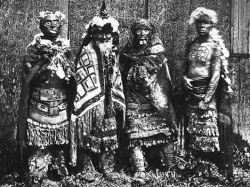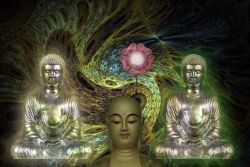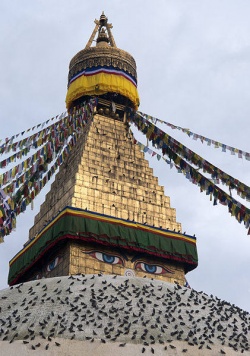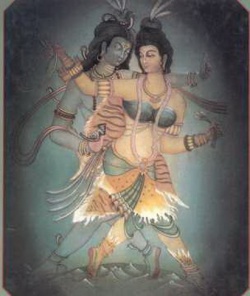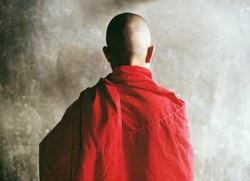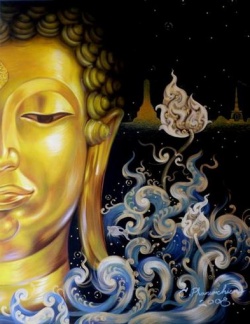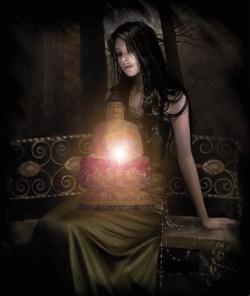Bhikkhuni ordination
Bhikkhunis (nuns) are one of the four-fold assembly of the Buddha's followers in early Buddhism and in what it later became known as, the Theravada.
The other members of the four-fold assembly are bhikkhus (monks), Upasaka and Upasika (lay men), and upasikas (lay women).
==Timeline of Bhikkhuni ordinations==
- 528 BCE The Buddha attains enlightenment and begins teaching the Dhamma.
- 500s BCE Maha Pajapati Gotami with five hundred women form the Bhikkhuni order, with permission from the Buddha; perhaps the first monastic order for women.
- 200s BCE Ven. bhikkhuni Sanghamitta, daughter of King Ashoka, goes to Sri Lanka with a sapling from the original Bodhi Tree and spreads Buddhism and the bhikkhuni order there.
- 200s BCE Buddhism is split between several different early schools.
The Vibhajjavada is the original Buddhism following the Pali Canon and includes the Theravada and the Dharmaguptaka.
- 100s BCE The Tipitaka is written down on palm leaves in Sri Lanka and includes several hundred pages of psalms and poems written by bhikkhunis, the only major religion with some of the scriptures written, compiled, or composed by women.
Common era
- 1017 The Orders of bhikkhus and bhikkhunis dies out in Sri Lanka due to the many invasions from foreign armies.
The bhikkhu line is restored in Sri Lanka from some monks from Thailand and Burma, but there were no nuns in those countries to restore the bhikkhuni line.
- 1017 to present: The Dharmaguptaka, which was under the same heading with the Theravada, under Vibhajjavada survives and has many nuns in China and Taiwan.
- 1996 Through the efforts of Sakyadhita, an International Buddhist Women Association, the bhikkhuni line was revived, in Sarnath, India.
The revival is done with some resistance from some of the more literal interpreters of the Buddhist Vinaya (monastic code) and lauded by others in the community.
- 2007 In Hamburg, Germany a conference is held, the International Congress on Buddhist Women's Role in the Sangha, which includes Bhikkhu Bodhi and the Dalai Lama.
Vinaya masters and elders from traditional Buddhist countries and Western-trained Buddhologists attended.
The Summary Report from the Congress states that All delegates "were in unanimous agreement that Mulasarvastivada bhikkhuni ordination should be re-established."
- 2009 In Australia, led by Ajahn Brahm 4 novice nuns are given the full ordination with Ayya Tathaaloka as preceptor and included the double ordination ceremony with monks included in the ceremonies.
Also in attendance were numerous lay people.
- 2010 In Northern California, 4 novice nuns are given the full ordination, which included the double ordination ceremony.
Bhante Gunaratana and other distinguished monks and nuns were in attendance.
The following month, more full ordinations are completed in Southern California, led by Walpola Piyananda and other distinguished monks and nuns.
Regular ordinations of women to the Sangha now appear to be the norm as debates about "reinstatement" begin to fade.
==The Buddha's initial reluctance==
After Siddhattha became the Buddha, Maha Pajapati Gotami approached him and asked if he would allow her and other women to renounce the world, thus becoming nuns.
The Buddha was very reluctant to do this but Ananda interceded on Gotami’s behalf.
He asked if women had the same spiritual potential as men and the Buddha replied, “Having gone forth from home into homelessness in the Dhamma and discipline women are able to realise all the states leading to enlightenment and enlightenment itself.’
Then Ananda asked the Buddha to consider how kind and helpful his foster mother had been to him. ‘Lord, Mahà Pajàpatã Gotamã was of great help to you – she is your aunt, your foster mother, she gave you her milk and suckled you when your mother died.’ Moved by these words, the Buddha decided to allow women to become nuns.
Why was the Buddha so reluctant to take this step? At this time there were no monasteries as such, monks lived in the forest or in parks on the outskirts of towns and cities.
Although the position of women in Indian society was much higher that it later became, a lone woman still stood a good chance of being thought of as loose and being open to harassment or worse.
The Buddha probably thought that having women living in forests posed too many difficulties. As it is, this turned out not to be the case.
Many scholars and teachers have theorized some possibilities for the reluctance:
- The condition and status of women at the time, would mean that fewer people would become interested in Buddhism if women were ordained. As people progressed, at a later date the ordination would be better.
- Because these women (many who were mothers, daughters, wives, sisters, cousins of many of the bhikkhus) might be subjected to rape, assault, sexual harassment and being termed "prostitutes and thieves", which in fact, did later occur as recorded in the Vinaya.
- The Buddha was testing Ananda, Maha Pajapati Gotami, and the other women to see how devoted they really are.
There is some evidence to suggest the latter may be true. In the Suttas it is reported that previous Buddhas (fully enlightened teachers of the masses) also had a bhikkhuni order.
Bhikkhu Dr. Analayo, a scholar monk has been a strong advocate for bhikkhuni ordination and in his research feels that the Buddha was misrepresented in the texts about being reluctant to ordain women. Ven. Dr. Analayo pointed out an obvious timeline discrepancy that amazingly has gone undetected until now.
It involves the deeply held belief that Ananda played an instrumental role in the founding of the bhikkhuni sangha.
He was credited, and later chastised by the First Council, for advocating for the ordination of the Buddha's maternal aunt and stepmother, Mahapajapati.
In a paper presented at the University of Marburg, Germany, Ven. Dr. Analayo writes, "There are many problems chronologically, however, in the traditional account of Mahaprajapati (from the Commentaries).
She first requested ordination five years after Buddha's enlightenment; but Ananda, who requested Buddha on her behalf, first ordained only twenty years after Buddha's enlightenment.
Considering that Mahaprajapati, as Buddha's maternal aunt, raised him after his mother's death, she would have been about eighty years old when Ananda was senior enough to make the request."
==Bhikkhuni reinstatement==
To be properly ordained, a nun must be ordained first by a quorum of nuns and then a second time by a quorum of monks.Dual ordination
In Theravada lands the nun’s lineage died out around the turn of the first millennium and traditionalists do not believe that it can or should be revived because there are no nuns to ordain new nuns.
However, the nuns lineage continues in most Mahayana countries, and, in places like Taiwan, nuns are a dynamic and respected presence within the Buddhist community.
In 1996 through the efforts of Sakyadhita, an International Buddhist Women Association, the bhikkhuni line was revived. This was done by using the Mahayana nuns for the double ordination ceremony.
The Mahayana nuns had a dual ordination both in Theravada and Mahayana, so the line never did completely die out, just the exclusively Theravada line of bhikkhunis.
The Mahayana nuns from Taiwan can trace their lineage to the Dharmaguptaka- Vibhajjavada, which is the precursor to Theravada.
Therefore, many teachers and scholars have applauded the reinstatement. Today there are more than 1,000 fully ordained bhikkhunis, just as the Buddha allowed for and wished for.
==See also==
==References==
Source
http://www.dhammawiki.com/index.php?title=Bhikkhuni_ordination

